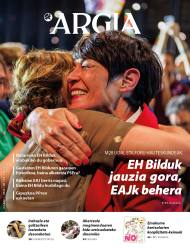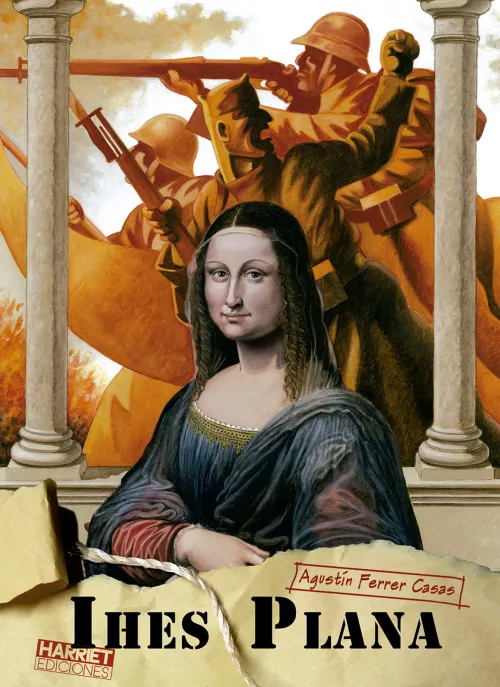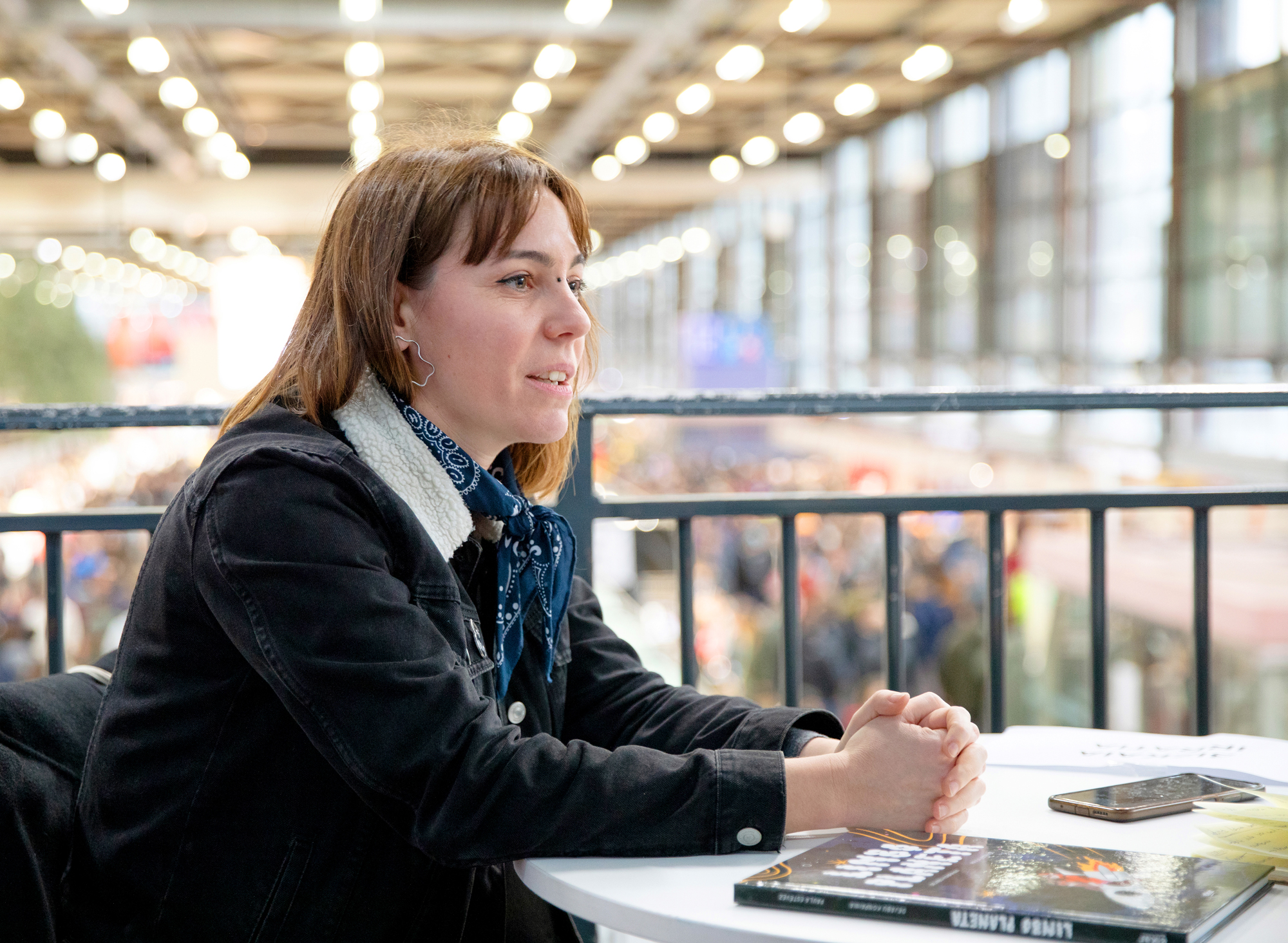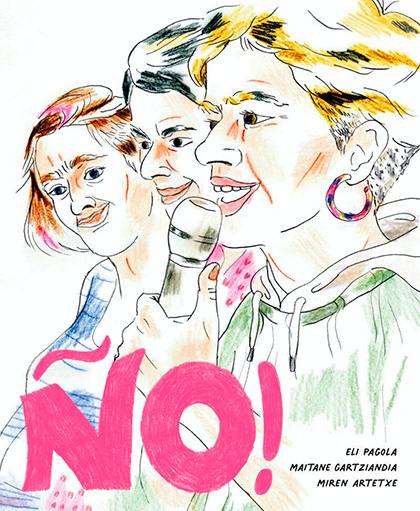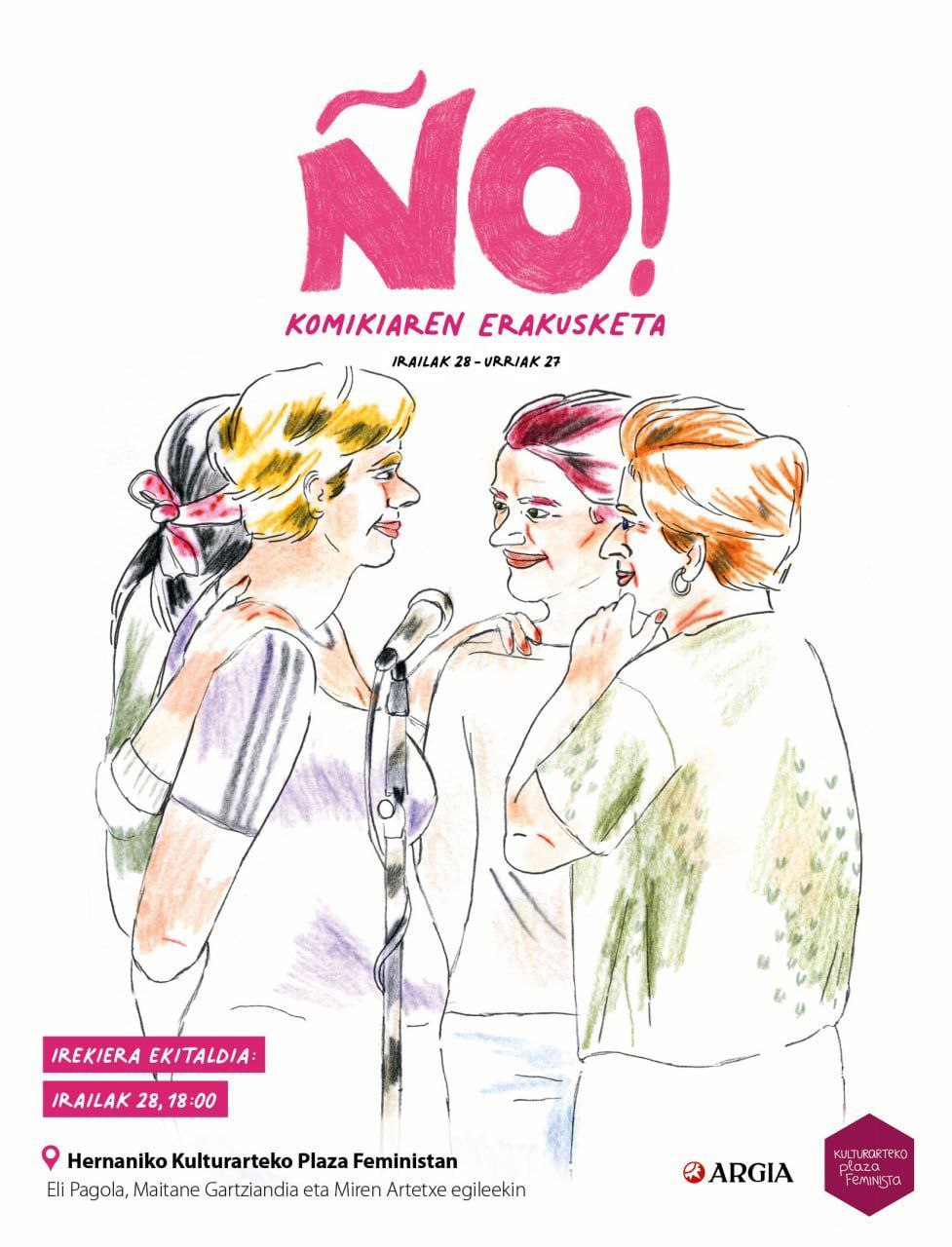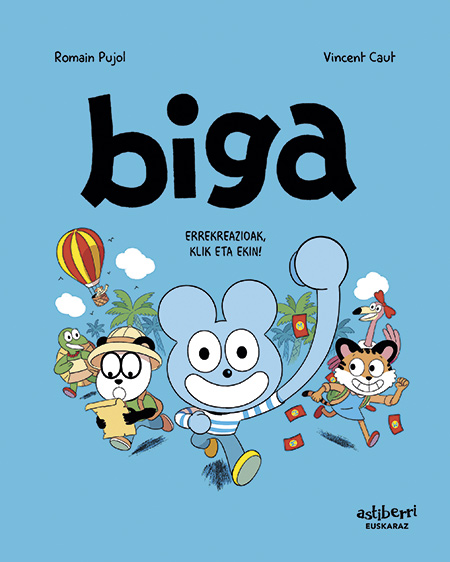"We've gained the opportunity to make our humor in some spaces."
- With the experiences of Bertsolaris women in the city center, Ño has collected ten scenes that can happen in a bertsos session. in the comic book (ARGIA, 2023) the illustrator Maitane Gartziandia and the author of the texts Miren Artetxe and Eli Pagola. Ten small tangles reflecting ghosts, obstacles, loops and tools to advance, praising the gesture of complicity and pleasure.

On the way to car trips, the feminist demonstration, the sweats cast in a competition, the internal war of the enigmatic, the allied audience and the alien public… You have curated a comic with ten scenes, has not started or finished a continuous story.
Eli Pagola: Because it's not a comic about a bertsolari, but something more general. Rather than focusing on a character, we wanted to describe scenes.
Look at Artetxe: Some passages are the ones we had lived, others we could live, or those we have been told, or those we have imagined… The truth is that there are very different female bodies in Bertsolarism and that not everyone experiences the same situations. The comic book has allowed us to show different scenes. We don't all walk in championships, we don't sing in bertsos dinners, or in some.
Precisely, Maitane, has highlighted the presence of the body in the comic book before starting the conversation.
Maitane Gartziandia: It is no accident that the first scene [the woman in the shower before going to the session] and the last [the affective relationship between two women] are the most everyday and intimate moments, the women are naked... Throughout the comic are people, faces and not so much the environment. We think bertsolarism is something that comes out of the inside of the head, but the body is also important, and that has weight in the drawings.

Why the comic book?
E. Pagola: More theoretical works linking Bertsolarism and gender have been carried out and will be carried out. We saw that a comic book job could have a margin. It also gives us permission to make jokes about it.
M. Artetxe: It's a comic book to smile at our peers and the feminists of our bertso world, which will give them strength to move forward. It is true that many things are not explained, and it is possible that the reader who does not know the world of bertso may have some references, but well, in general, what is known about gender issues will certainly identify some situations, although they do not belong to the world of bertso, but to music, to literature, or ...
They talk about theoretical works. The comic has little theory, there are hardly any big words. They have gone another way.
M. Artetxe: For the audience of the world of bertso our discourse is already super developed, how gender systems go through a social and cultural practice like Bertsolaris... Among all of us we have very detailed, everyone has material there. Our intention was to show how this materializes, and for that purpose images, for example, have seemed very suitable resources, because scenes are counted.
There are no bertsos in the comic book, except the selection of Joxepa Antoni Aranberri ‘Xenpelar’ you received at the end.
M. Artetxe: It's been for laziness. No, it seemed to us that if we put some concrete verses that have been sung on one occasion, they would be “similar” or “of the other”, and we wanted it to be something coral. In some scenes they might be fine, but it seemed to us that the text would become too important.
E. Pagola: That's it. The inclusion of verses in a work of bertsolarism would have a great presence, and we had no interest in it.
M. Gartziandia: Every scene is a picture. These are photographs or frames of the isthantes of a few seconds, very descriptive, in which action is not so important, but to describe a sensation, an environment.
M. Artetxe: For us, when we're going to sing to a site, the moment we're talking about is minimal, we spend more time before and after, because we go. The moment we are talking about is perhaps the most comfortable, because we know how to do it; the important thing was to describe other moments.
The same is to say more, but reading the comic book you can see that they feel “comfortable” in more places.
E. Pagola: The camps are changing, there is work by bertsolari and the public, feminism has advanced and strategies have been developed that allow them to feel more and more comfortable. These strategies are not exclusive to oneself, or only to bertsolaris in this case, but other complicities arise, such as predisposing or public issues. That's why it's changing a little bit of a place.

The audience is quite important in comics.
M. Artetxe: After all, from the place of the bertsolaris we see the audience, and we see people who want to hear from you what they think or who, on the contrary, have no interest in listening to you, your attitude will change and the rhymes will be more or less easy for you. It was important to pick it up. At the discursive or theoretical level, it is always said that the public actively participates in the construction of the verse and that it also influences the practice we wanted to demonstrate.
All with a touch of humor.
E. Pagola: Yes. But behind it is a lot of crumb. It looks like a comic has to have nice images and be it lami or aja, but it's something done with a lot of bibliographic references, but then it's not written. As Mira tends to say, more than complaints, we protest. There's humor because we don't want to victimize ourselves. We know what is there and it is an active decision to try to influence it.
M. Artetxe: Humor is also a survival strategy for us. When we talk about alliances, complicity, fraternity -- we're not saying we're giving massages all the time, we're laughing at the situation, we're laughing at the situation, we're laughing at the situation, we're laughing at the situation, we're laughing at the situation, we're laughing at each other, with a fine irony and sometimes clumsy. A strategy is necessary to persevere in the bertso, and it may reflect that. In the car scene, for example, we've collected things we've been telling ourselves about, and we don't talk about crying about them.
"These are stories from a few seconds, very descriptive, in which action is not so important, but to describe a sensation, an environment." Maitane Gartziandia
Humor reproduces, among other things, power relations. I have read on several occasions that there is a hegemonic humor in Bertsolarism. Is this changing?
E. Pagola: No.
M. Artetxe: Y punto. Other questions? [laughter]. I think humor almost always reflects a power relationship. What happens is that we have gained the opportunity to make our humor in some spaces, because in feminist sessions, among other things, we share a centrality with the public and know, for example, that we can say nonsense that we would not say in other places, like singing on the paper of a man or a male chauvinist woman. New forms of humor are being created in some areas. In hegemonic spaces, when we are not following, but when we are asking questions: “Can this be said? And that other?”
The debate about the evil of humors is often sterile, but -- do you think comedians can offend anyone?
E. Pagola: When you do something with humor, it's very difficult for anyone to feel hurt. But it is different who feels hurt; in this case, when we talk about bertsolarism, if you will feel hurt the most open and powerful subject, well...
M. Artetxe: I think we have taken special care in that the readers can identify nobody in the drawings, the name criticized has not been explained, there is no reference to something that has actually happened in a particular square...
M. Gartziandia: I have taken from real pictures to capture the best possible body expressions, but I have taken special care not to personalise anyone because we put faces easily. The important thing was not who appeared on these pages, but what is happening.

And, Maitane, how has it been working with a couple of writers?
M. Gartziandia: We think together the script in the Biko Teka workshop held in Pamplona in 2021 [organized by the Galtzagorri association together with the city council]. Eli and Miren were putting up scenes and I myself sketched out at the moment. I think this is not the most usual thing, because normally the draftsman starts working once he receives the texts. I made drawings, and then they included interviews and texts. We've been together.
That's right, as always happens, what I draw passes through my filter, or what I can do, and it can be hard for me to imagine something of a more self-contained world. I draw what I have left and not what I have seen from the writer's place. In recent weeks, I have been making small changes. We must always negotiate.
You've used color and not black and white.
M. Gartziandia: I usually worked more black and white with the pencil. But in this case, when we started talking, I immediately imagined a very colorful comic book. The touch of humor asked me color, although for me it would be a challenge.
E. Pagola: We were lucky because we were allowed to participate as trios in Biko Teka. On that one-week day, all three of us met fairly easily and we got out with a clean skeleton. As we have worked with Maitane we have been combing the texts, but we have not got too hooked.
M. Artetxe: There are dialogues aimed at creating an environment, they made us very natural and we went out easily; with the words of Joxepa it has not been so tender, because we were not very clear where and how to make the counterpoint.
M. Gartziandia: It has been nice that each scene has its own visual game, with each idea a kind of game is created, in each and every other we have used different resources, in the case of Joxepa we have made photographic mounts in black and white to represent the historical jump and change of record.

In fact, the cartoons and photographic montages starring Joxepa Antoni Aranberri Petriarena ‘Xenpelar’ (1865-1943) have interspersed in the comic book, and in the end they have received a selection of their verses, a response to a bertso against the singles of Enrike Elizetxe. Why?
M. Artetxe: It was Joxe a way of saying that we are not the first or the last to implement empowerment strategies. It is not suddenly that we have come and said, “we came to empower!”, but that women have been acting for centuries in berts and that they too would use their strategies. We used it to represent it, to laugh at ourselves, because we didn't want a man to do it.
E. Pagola: Their verses are known. We wanted to make it clear that he was not a character invented by us. What he says in the comic book we have invented, of course, but if the woman was the one to respond -- we haven't been the first to mobilize ourselves or the ones who have had to develop strategies to position ourselves in the world of bertso.
In what sense do we mobilize?
E. Pagola: It has to do with the development of strategies. For example, in the case of a comic scene, make us feel that we are driving together, comment on the program’s themes together, create our own sessions to work on other forms of bertsolarism that we have in our mind and make our spaces… We don’t just wait for a session to be the only girl on the program.
In one of the scenes of the comic book, when the bertsolaris go by car on their way to the program, man eats the word to the woman; in another, already in the singing, the woman is almost forced to touch the tone of the man...
M. Artetxe: Some voices have different weights. You have to take into account, for example, in car travel with what a young woman can say, while what a man can say, more if he's a driver, is heavier. They say, "Well, talk, talk," but it's not so easy to say, talk or do.
Are male shades often overrun?
E. Pagola: It's more common than not.
M. Artetxe: Notice who wins the fight. Little chicks are nice.
"We, as Miren tends to say, protest more than complaints. There's humor because we don't want to victimize ourselves." Eli Pagola.
They talk about the young woman. With the comic, you'll feel equal to young women than older women, right? Also men, and not just bertsolaris.
E. Pagola: We've tried to make it as broad as possible, but it's us, we're the age we have, the experiences and friends we have -- a picture of everything isn't easy, surely the closest ones will more easily identify some things, but I think most of the components are universal, not perhaps exactly as they're collected in the comic book, but many would live similar.
M. Artetxe: The comic book is today, if we had done some work on the problems of women in the years 1970-80-90, it would be different, we would surely have been able to write more nonsense, but I think many readers will not be surprised what is there.
There are many gestures of brotherhood or complicity in the comic: comments, looks, hugs...
M. Artetxe: Many women have shared spaces both in the feminist world and in those related to Bertsolarism, which has necessarily meant friendship, closeness and affection among us. That's noticeable. We don't know other girls personally, but we know that they live our same problems, even consciously. In this respect, I know that the person next to me has also understood this, for example, in car travel. This inevitably creates alliances, even if they are not of affection or friendship, but there are other alliances that were previously impossible. If I know that a young woman is in the feminist movement of her region, and if in the car they are making us a terrible mansplaining, then on the way to the bathroom I do not hesitate to talk or not about the issue with her, I know that she is also aware.
I would ask you for more scenes, but I don't want to do the handler and discover the mystery.
M. Artetxe: Lasai, it's a comic book without mysteries.

Ihes plana
Agustín Ferrer Casas
Itzulpena: Miel A. Elustondo
Harriet, 2024
---------------------------------------------------------
1936ko azaroaren 16an Kondor legioko hegazkinek Madrilgo zenbait museori egin zieten eraso. Eta horixe bera da liburu honetara... [+]
SCk Zerocalcareri egindako galdera sorta eta honen erantzunak, jarraian.
Bildumako azken alea izango dela jakinarazi dute: lehenbizikoa Ni-ari buruzkoa izan zen, eta bigarrena Zu. Bigarren hura bezala, autoedizioan kaleratu du honakoa ere.
Ño!
Texts: Illustrations Eli Pagola and Miren
Artetxe: Luz Maitane
Gartziandia, 2023
------------------------------------------------------
Before and after the comic, both on the skin and back provided, as well as inside tapas and tapas, there are images and words... [+]
Biga (5 books)
Screenplay: Illustrations Romain
Pujol: Vincent Seguros
Astiberri
----------------------------------------------------
We've read eleven stories at home to our seven- and nine-year-olds, and I would say that I've never seen them so hooked that with the... [+]
Screenplay
Anker: Gregorio muro harriet
Illustrations: Alex Male
Color: Garluk Aguirre
Harriet, 2023
The Anker comic is located in January 2019. In the Russian regions, near the borders of China and North Korea. It shows the mafias that are flourishing the Siberian... [+]







